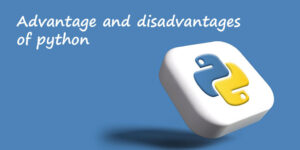
Are you looking for Python interview questions and answers? Buckle up! Get ready to embark on a career path that offers limitless possibilities.
Python is widely regarded as the most popular programming language in the technology industry. For people who are planning to enter the domain of programming or want to switch to a better domain, Python is an important language to acquire. Whether you are preparing for an interview or are planning to interview a new candidate for the software engineer post, then you’re on the right platform.
During the interview, you will be required to solve a challenge using Python and provide explanations for complex Python functionality. In order to successfully navigate the technical and coding stage, it is beneficial to have a guide or access to mock questions for practice. Possessing knowledge and skills in Python can provide you with numerous career opportunities, including roles such as Software Engineer, DevOps Engineer, Data Scientist, Research Analyst, and more. This proficiency can give you a competitive advantage in the job market.
Believe it or not, working in your dream job can lead to a happy life.
So, if commencing your career as a Python developer is your dream, then you need to crack the interview. For that, you must explore the list of questions that include basic Python interview questions to advance.
Yes! This article assists in enhancing your knowledge of Python from the interview perspective. So don’t miss it! Scroll down to read the full article and gain insights on Python Interview Questions and Answers.
Let’s get started…
Python Interview Questions and Answers
Here is our rundown of the most asked Python interview questions and answers. This comprehensive list consists of interview questions and answers for both fresher and experienced professionals to perform well in interviews.
Let’s begin with the basic Python interview questions! Take a look…
Q. 1: What is Python?
Python is a dynamic, interpreted programming language. It is known for its relatively simple syntax. This makes it an excellent option for beginners who are just beginning their journey in the programming field.
Plus, it supports objects, threads, modules, exception handling, and automatic memory management. Moreover, in a few lines of code, you can compile a large program. Using its simple syntax, library functions, and specifications, developers can build unique applications. All in all, Python is a highly versatile language that can be utilized for a wide range of tasks across various industries.
Q. 2: Why is Python so popular?
Candidates should be aware that such Python interview questions are pretty normal in interviews. Be prepared with a relevant answer. You can tell all the good features of Python that make development a breeze.
For web and software development, Python is one of the well-fined languages. The main thing is that it creates complex, multi-protocol applications while maintaining concise, readable syntax.
Q. 3: How is multi-threading achieved in Python?
Typically, multithreading refers to doing multiple tasks concurrently. Importing a threading module is important to create a thread successfully. In three different ways, programmers can achieve multi-threading in Python. Such as:
- Without creating a class
- By extending the thread class
- Without extending the thread class
Q. 4: What are Global, Protected, and Private Attributes in Python?
In Python, global, protected, and private are access modifiers; they control the visibility and accessibility of class attributes.
Global Attributes: As the name suggests, it can be defined and accessed from anywhere in the program, including inside the classes.
Protected Attributes: This attribute is commonly defined with the ‘’ underscore before the attribute name. It is allowed to be used within the class and its subclasses.
Private Attributes: This attribute is denoted with a double underscore ‘ _’ before the attribute name. The attribute can be only accessible where it is actually defined on that class.
These are some of the basic Python interview questions, so go through them thoroughly.
Q. 5: What Type of Language is Python?
Python is best known as an interpreted programming language. On the other hand, it is also a high-level, general-purpose, and dynamically typed scripting language. And it is used in several fields.
Q. 6: How did Python Emerge as an Important Language?
First of all, Python is a simple and easy-to-understand programming language. Only with fewer lines of code you can compile and run complex programs. Comparatively, it is easy to learn in a short period.
Python become stable in data science and allows professionals to use the language without complex statistical calculations. Most importantly, it builds machine learning algorithms, manipulates, analyzes, and competes with other data-related risks.
It is one of the basic Python interview questions for freshers. Thus, if you’re a fresher, then utilize it.
Q. 7: Write a Python Program to Print the Number is Odd or Even
num = int(input(“enter a number:”))
if (num%2) = = 0:
print(“{0}is even number”.format(num))
else:
print(“{0} is odd number”.format(num))
This is a basic Python interview question, practice every question because sometimes answering the easy question could be a huge challenge.
Q. 8: Is Python an Interpreted Language or a Compiled Language?
Python is a language that is both interpreted and compiled. This refers to the process of compiling the source code before it is concealed from the programmers. Afterward, the code is transformed into byte code and then executed by the Python virtual machine.
It is one of the most frequently asked Python interview questions to test the programmer’s knowledge.
Make sure to include it on your list of the most important interview questions.
Q. 9: Write the Code to Copy Objects in Python.
In Python, there are only two ways to copy objects, such as shallow and deep.
Shallow Copy
import copy
l = [[1,2], [3,4],[5,6]]
new_list = copy.copy(l)
print(“Old List:”, l)
print(“New List:”, new_list)
To try the deep copy method with the same code, replace copy(1) code with deepcopy(l).
Try to execute this Python coding interview questions and answers and understand the concept clearly.
Q. 10: Difference Between Range() and xrange() Functions in Python.
Both range() and xrange() functions are used to generate a sequence of numbers within a given range in Python. The function xrange() is only used in Python 2. x, whereas range() is only used in Python 3. x.
The range() function can return a range object(a type of iterable).
The xrange() function returns the generator object. So, it can only be displayed by using the loop.
Q. 11: What is the Use of init () in Python?
In the OOPS concept, it is known as a constructor. The init () method is always declared inside the class and used to initialize the attribute of an object immediately when it is created at that moment.
While defining the init (self) method, the ‘self’ – default parameter is passed as an argument. It represented the object of the class itself.
Q. 12: List Examples for List, Dictionary, and Tuple in Python
Python’s built-in data structures are lists, tuples, sets, and dictionaries. These are used to store and organize data efficiently.
List: represented with [ ]
Example for List: [1, 2, 3, 4, 5]
Dictionary: represented with { }
Example for List: {1: “a”, 2: “b”, 3: “c”, 4: “d”, 5: “e”}
Tuple: represented with ( )
Example for Tuple: (1, 2, 3, 4, 5)
Practice examples on the editor while checking Python interview questions to give a better explanation to the recruiter.
Q. 13: What are the Mutable Data Type and Immutable Data Type?
Mutable objects can have their value or data modified without changing the object’s identity. On the other hand, immutable objects do not permit any kind of modification.
Mutable data type allows you to change after initialization.
Mutable data types represent lists, dictionaries, sets, and user-defined classes.
The immutable data type is in contrast to mutable; it won’t allow you to change the value after initialization.
Immutable data types: numbers (integer, float, complex, decimal, rational & Boolean), tuples, strings, and frozen sets.
Q. 14: Are Arguments Either Passed by Value or by Reference in Python?
In general, arguments are passed by reference in Python. So, the changes are reflected in the original object.
Example:
def fun(s):
a[0]=3
a=[1,2,3]
fun(a)
print(a)
Output: [3, 2, 3]
While checking Python interview questions and answers recall everything with examples and clear the interview.
Q. 15: Is it Possible to Remove all Leading Spaces in a String? How?
Yes. By using one of the already in-built functions lstrip(), it is easy to remove all leading space from a string.
Example:
” Python”.lstrip
Output: Python
Q. 16: What is Monkey Patching in Python?
Monkey patching in Python refers to the act of modifying or updating a piece of code, class, or module during runtime. It gives users the ability to modify the behaviour or functionality of a class or module during runtime without having to alter the entire Python code. Instead of changing the whole Python program, the technique helps to change the working or behaviour of a class or module at the run time.
Q. 17: Explain briefly the top 3 Applications of Python
Here are the top three applications of Python:
Data Science
Python libraries allow for analysing large data sets quickly, which makes it an efficient language for the Data Science field.
Web Development
It is a flexible programming language that helps to build complex web apps. Python hugely contributes to the web development field and offers several frameworks for web development.
App Development
App development becomes simpler and easier with Python’s cross-platform flexibility. It is an ideal language for prototyping, which is the major reason developers use this language. It lowers the development time and effort for them.
Don’t think that Python interview questions are always related to coding only.
Q. 18: Why do Data Analysts Use Python?
Another important Python interview question is why data analysts mostly use it.
Due to the flexibility, scalability, and impressive range of libraries, most Data Analysts choose to work in Python. That’s why it’s more popular than other programming languages like JavaScript, Scala, and more.
Also Read: Top Data Analyst Interview Questions and Answers for Job
Q. 19: Describe Python Programming Language in Web Development.
Python offers a wide variety of web frameworks, including Django, Flask, and Pyramid. These frameworks provide the essential tools and features required for web development. Additionally, they assist in organizing the codebase and encouraging the reuse of code.
It’s one of the most important Python interview questions!
Q. 20: What are the Keywords in Python?
Here are some of the most common Keywords used in Python:
Value Keywords – True, False, None
Operator keywords – and, or, not, in, is
Control Flow Keywords – if, elif, else
Iteration keywords – for, while, break, continue, else
Returning Keywords – return, yield
Import Keywords – import, from, as
Exception- Handling keywords – try, except, raise, finally, else, assert
Asynchronous programming Keywords – async, await
Variable handling Keywords – del, global, nonlocal
Q. 21: Explain how Memory is Managed in Python
The private heap in Python is responsible for storing all Python objects and the necessary data structures for managing memory. Furthermore, the memory manager automatically deallocates itself when an object is no longer in use.
It is yet another one of the frequently asked Python interview questions.
Q. 22: Differentiate Statically Typed Language and Dynamically Typed Language
This is yet another very important Python coding interview question and answer.
Dynamically typed language
Code will get interpreted even if it contains an error and the variable without its type is initialized.
Statically typed language
The code will not be complied with until all the errors are corrected.
Q. 23: Give the Names of the Top 10 Python Library in Recent Times
- Pandas
- NumPy
- Keras
- TensorFlow
- Scikit Learn
- Eli5
- Scipy
- PyTorch
- LightGBM
- Theano
Go with these advanced Python interview questions and answers to be confident.
Q. 24: How do you Differentiate Django and Pyramid in Python?
Pyramid
It is a flexible and lightweight web application framework written. Also, it supports the usage of various well-known single-file web apps.
Django
Django is a high-level web application framework that provides an ORM that helps to manage database operations securely.
Q. 25: Describe Multiple Inheritance and Multilevel Inheritance in Python.
Multiple Inheritances
If a class derives from more than one base class, then this type of inheritance is called multiple inheritances.
Multilevel Inheritance
Multilevel Inheritance is a type of inheritance that is already inherited with some other class. It means the subclass can be derived from a parent class. Also, the subclass can be used as a parent class for another.
Q. 26: List 5 Methods to Delete a File in Python
It is important to prepare this if you’re preparing Python programming questions.
Here is the list of top 5 methods to delete file in Python:
- os.remove(file_path)
- os.rmdir(directory_path)
- shutil.rmtree(path[, ignore_errors[, onerror]])
- pathlib.Path.unlink(missing_ok=False)
- pathlib.Path.rmdir()
Q. 27: Write and Explain swapcase() Function in Python
Swapcase is a simple and important Python programming interview question, so don’t forget to go through it. This method returns a string where the lowercase letters are uppercase and vice versa.
Example
string = “it is in uppercase.”
print(string.swapcase())
string = “IT IS IN LOWERCASE.”
print(string.swapcase())
Output
IT IS IN UPPERCASE.
it is in lowercase.
Q. 28: What is the best way to debug a Python program?
Python –m pdb Python-script.py is the command for debugging a Python Program.
Q. 29: What is Negative Indexing in Python?
In Python, negative indexing is a specialized feature available in arrays and lists. Python starts indexing the positive integer from the beginning of a list or array but reads items from the ending of a list or array in a negative index.
Q. 30: Solve this pseudo code.
import array
a = [4, 8, 9, 10, 7, 1]
print(a[-3])
print(a[-1])
print(a[-4])
Output
10
1
9
Q. 31: How do you Create Random Numbers in Python?
Many functions are available to create random numbers in Python.
random() – It gives a floating-point value from 0 to 1.
randint(X, Y) – It gives a random integer between X and Y values.
uniform(X, Y) – In the X and Y range, it gives a floating-point value.
Q. 32: List the Advantages of Python
- It is free and open-source.
- Python is simple to learn, read, write, and understand.
- Python is a dynamically typed language that doesn’t require any pre-defined data type for any variables that are interpreted at runtime.
- Extensive library support, so you can import additional packages (pip).
- Can effectively optimize code that frees up memory.
Q. 33: What is Pass Command in Python?
The pass command is the placeholder of a future code and is one of the loop controls in Python. In simple words, it does nothing (null action) because when it runs, nothing happens. You can use it if you need to write a code block but don’t want to run it.
Example: Using functions
def myEmptyFunc():
pass
myEmptyFunc()
Q. 34: In what Fields is Python Used?
Python offers enormous advantages. It is an open-source, free-interpreted language that is extensible and very flexible for developers. It is used in many fields, such as
- Web and Internet development
- Games
- Operating system
- Image processing and graphic design applications
- Enterprise and business application development
- Scientific and computational applications
- GUI (Graphical User Interface) based desktop applications.
Q. 35: How does Python Manage Memory?
It uses automatic memory management through garbage collection, and it tracks the objects. When these objects are no longer in use, it frees the memory. Plus, Python also has context manager tools, and with the statement, it releases the resources automatically.
Q. 36: What is Slicing in Python?
Slicing refers to the process of extracting a portion of a string, list, or tuple. This feature allows users to access specific elements within a range by specifying their indices. The object can be sliced using the syntax [start:stop:step]. The parameter “start” indicates the index at which a slice should begin. The “stop” parameter specifies the ending element of a slice. Step in the process denotes the number of steps to jump.
Slicing can be done on lists, arrays, tuples, and strings. However, the default value starts from 0, the step is 1, and the number of items is stop.
Q. 37: What are Unit Tests in Python?
The unit test refers to testing different components of the software. While explaining this question, try to include some examples that resemble your deep knowledge of Python. It will give the recruiter the idea that you are well-versed in the language.
For instance, consider components like A, B, and C. Now, there is a break in your software, so examining each component separately is undeniably important. In this case, you can perform the unit test and identify which component is the reason for software failure.
Q. 38: What is “Scope” in Python?
In Python, the scope is a term that refers to the area of a variable that is accessible and visible to other code. If a variable is declared inside a function, then it comes under local scope, which means the variable can’t be accessed from outside of the function.
When variables are defined and accessed in or outside of any function, they are global scope variables.
It is an important Python programming question, so don’t skip it.
Q. 39: List Python literals
- String literals
- Boolean literals
- Numeric literals
- Character literals
- Special literals
Q. 40: Describe Docstring in Python
Docstring – A document string is a multiline string that documents a specific code segment. It must describe what the method or function does.
Q. 41: Why is Python Important for the Future?
Python is widely used in web development, particularly in the creation of web applications. This is due to the availability of popular web frameworks like Django and Flask, which greatly simplify the process of building web applications. Python is widely favoured for scripting and automation tasks due to its simplicity and user-friendly nature.
Bottom Lines
So, there you have it: the top 41 Python Interview Questions and Answers. You can use these Python interview questions to grab the developer role effortlessly. Shape yourself into a well-versed Python programmer and develop custom-tailored applications. Also, it is crucial to enhance the problem-solving and critical thinking capabilities to stand tall among the others in the developing field.
Keep learning, keep coding!
Best wishes to commence your coding journey!






